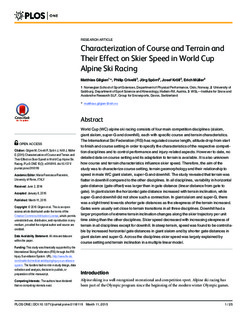| dc.contributor.author | Gilgien, Matthias | |
| dc.contributor.author | Crivelli, Philip | |
| dc.contributor.author | Spörri, Jörg | |
| dc.contributor.author | Kröll, Josef | |
| dc.contributor.author | Müller, Erich | |
| dc.date.accessioned | 2016-04-06T07:56:44Z | |
| dc.date.available | 2016-04-06T07:56:44Z | |
| dc.date.issued | 2015-03-11 | |
| dc.identifier.citation | PLoS ONE. 2015,10, e0118119. | nb_NO |
| dc.identifier.uri | http://hdl.handle.net/11250/2384134 | |
| dc.description | Copyright: © 2015 Gilgien et al. This is an open access article distributed under the terms of the Creative Commons Attribution License, which permits unrestricted use, distribution, and reproduction in any medium, provided the original author and source are credited. | nb_NO |
| dc.description.abstract | World Cup (WC) alpine ski racing consists of four main competition disciplines (slalom, giant slalom, super-G and downhill), each with specific course and terrain characteristics. The International Ski Federation (FIS) has regulated course length, altitude drop from start to finish and course setting in order to specify the characteristics of the respective competition disciplines and to control performance and injury-related aspects. However to date, no detailed data on course setting and its adaptation to terrain is available. It is also unknown how course and terrain characteristics influence skier speed. Therefore, the aim of the study was to characterize course setting, terrain geomorphology and their relationship to speed in male WC giant slalom, super-G and downhill. The study revealed that terrain was flatter in downhill compared to the other disciplines. In all disciplines, variability in horizontal gate distance (gate offset) was larger than in gate distance (linear distance from gate to gate). In giant slalom the horizontal gate distance increased with terrain inclination, while super-G and downhill did not show such a connection. In giant slalom and super-G, there was a slight trend towards shorter gate distances as the steepness of the terrain increased. Gates were usually set close to terrain transitions in all three disciplines. Downhill had a larger proportion of extreme terrain inclination changes along the skier trajectory per unit time skiing than the other disciplines. Skier speed decreased with increasing steepness of terrain in all disciplines except for downhill. In steep terrain, speed was found to be controllable by increased horizontal gate distances in giant slalom and by shorter gate distances in giant slalom and super-G. Across the disciplines skier speed was largely explained by course setting and terrain inclination in a multiple linear model | nb_NO |
| dc.language.iso | eng | nb_NO |
| dc.publisher | Public Library of Science (PLoS) | nb_NO |
| dc.subject | terrain | nb_NO |
| dc.subject | sports | nb_NO |
| dc.subject | geomorphology | nb_NO |
| dc.subject | antennas | nb_NO |
| dc.subject | linear regression analysis | nb_NO |
| dc.subject | pendulums | nb_NO |
| dc.subject | physical geography | nb_NO |
| dc.subject | specific gravity | nb_NO |
| dc.title | Characterization of course and terrain and their effect on skier speed in World Cup alpine ski racing. | nb_NO |
| dc.type | Journal article | nb_NO |
| dc.type | Peer reviewed | nb_NO |
| dc.subject.nsi | VDP::Mathematics and natural science: 400 | nb_NO |
| dc.subject.nsi | VDP::Mathematics and natural science: 400::Basic biosciences: 470 | nb_NO |
| dc.subject.nsi | VDP::Agriculture and fishery disciplines: 900 | nb_NO |
| dc.subject.nsi | VDP::Agriculture and fishery disciplines: 900::Agriculture disciplines: 910 | nb_NO |
| dc.source.journal | PLoS ONE | nb_NO |
| dc.identifier.doi | 10.1371/journal.pone.0118119 | |
| dc.description.localcode | Seksjon for fysisk prestasjonsevne / Department of Physical Performance | nb_NO |
